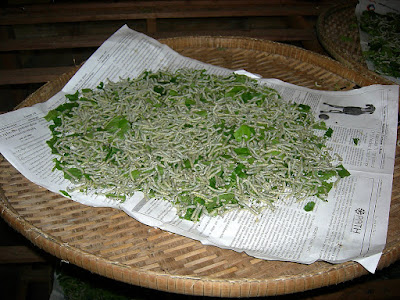On the way
A few things that stand out in memory which I forgot to mention earlier, after visiting Preah Promreah and crossing over the bridge, we were driving along and crossed yet another bridge and as we turned right, my driver slowed down and made to pull over on the corner saying to me, "You want to visit the crocodile farm and do a tour?" to which I replied, "No". He turned his head and asked didn't I want to see the crocodiles? People like to see crocodiles. I told him, "No thanks Pookeah, we got crocs back in Darwin". Evidently, this was something he hadn't enctountered before and thought it strange that I wasn't interested.
No crocodiles thanks, I'm Australian!
How to explain Australia has plenty of crocs - big salties up around the Top End and FNQ? (Far North Queensland) - I remember when I went to Darwin, Kakadu and Arnhem Land and went to Litchfiled NP, the "Jumping Crocs" cruise on the Adelaide Queen was included and I was so excited at actually seeing them instead of just in pictures or on the telly. And of all the many photos I took trying to capture a decent shot. I didn't have a digital camera then and when I think of all the money I spent paying to get the film developed. Anyway, at other places I've been to on my travels around Oz, overseas tourists are amazed that I don't want to "See the crocodiles" - crocs, like anything else, you've seen one (croc) you've seen 'em all!☺
I have water
There were a number of little stalls along the way and I wanted to stop at least one of them, not so much because I wanted to buy anything, (although I would have purchased something, otherwise I'd have felt like a real heel), but more because I really would like to have sat and chatted with people. So, after seeing yet another stall with colourful umbrellas and children running around, I called out to my driver, "Oh, could we stop here please and go back there?" Pookeah asked me why, and I said the first thing that came into my head (well I thought too that it was a reasonable request and sounded much nicer than saying I just want to have a look around and mix with the locals) - I said I'd like to buy a bottle of water.
"You want water? Is no problem, I have water here." And with that, he stopped, hopped off, went around the back of the tuk tuk, lifted up a lid and produced a bottle of water. Damn! Naturally I thanked him and smiled. And made sure I didn't let the disappointment show on my face.
That's not the silk farm
Driving on and drinking my water and having a few fags along the way (one of the greatest things I noticed in Cambodia - people don't get in a tizzy when you smoke, not like back home where you're made to feel like a leper) I saw a place on the right hand side on a corner saying "Silk Farm" - there's the silk farm are we going to stop there? "No that's not silk farm". But it says silk farm says I, not there says my driver, silk farm is up this way. Not understanding why he didn't stop, I sat back and enjoyed the ride. It wasn't till we had gone for a further twenty minutes or so, that I understood - for there, with a big sign was the silk farm. And it bore no resemblamce to the other little place we passed.
The silk farm I later found out, is located about a 20 minute drive from Siem Reap in the Puok district. As my driver was taking me on a "countryside" tour, it took far longer than the said 20 minutes, and I got to see so much more because of it.
About Artisans d'Angkor
Artisan's d'Anglor began in 1998. It was created to help the young people to find work in their home villages by providing them with high skilled training and a vocation from which they can earn a living.
Above: Artisans d'Angkor
Over a thousand people are employed by Artisans d'Angkor today and the establishment of rural workshops has helped to slow down the rural depopulation of Siem Reap surroundings by increasing income of rural Cambodian families. Cambodia has long been famous for its silk, and much of the country and population was decimated during the reign of the Khmer Rouge. By supporting its people and enabling them to find work, the government is trying to get the country back on its feet and learning the almost lost art of traditional hand-weaving is a value which can be handed down for generations.
Teaching
At Chantiers-Écoles young girls from the villages are brought here and learn all about the silk process and how to weave. Many of them live a long way from the town of Siem Reap - about 15kms. The Cambodia government and the French government pay for this. They sleep at the school and have their meals there. They have to pass a test and when they do, they go back to their villages where they can get jobs as weavers. This is how it was explained to me by Bunneano who showed me around the farm.
Above: Bunneano my guide
My driver said he'd meet me "over there" when I came out and showed me where the entrance was. I walked up this path with lovely shady trees, to the door and this lovely young man introduced himself to me saying his name was Bunneano and took me on a tour of the silk farm.
Silk Farm Tour
Above: Entrance
This lovely shady entrance is a welcome retreat from the heat and is set in lovely gardens.
Above: Three Angels
As we walked along the path on the right hand side, these little children were playing and let me take their photo. I asked their names but didn't write them down. Something I noticed, whenever I asked permission to take a photo, whether in Cambodia or Malaysia, they always make the "V" sign with their fingers.
Above: Mulberry plantation
Next we went passed the Mulberry plantation - lots and lots of trees, there are eighteen species grown here. We have a white mulberry tree in our back yard at home which has white mulberrys which I'm told by my landlord are edible and taste very nice. I said this to Bunneano and asked was it the same. It isn't, it's a different one to the trees which produce the leaves the silkworms eat.
Above: Silkworm eggs
The female moth lays many tiny little eggs - as many as 300 at a time.
Above: 12 day old silkworms
A little caterpillar hatches out of the egg. The caterpillars above are twelve days old, steadily getting bigger and fatter from their diet of mulberry leaves. As they get bigger and bigger, they go through four molts. They eat for three days and sleep for one day.
Above: Cocoons
The caterpillars spin a cocoon of silk thread around themselves and inside the cocoon, the caterpillar changes into a pupa.
Above: Lifecycle of cocoons
Above: The silkworm room
Here are a number of "plates" with silkworms of varying ages on them busily eating blissfully unaware that their little lives are almost over and they will go on to become a silk scarf around your neck or a pair of silken slippers on your feet.
Above: Silkworm harvesting - the old way
When the cocoons are the right age, they are harvested. This was the old way of harvesting and they could often get caught on the rough bits of tiwgs.
Above: The new way
The newer, more modern method is far superior to that of the old.
Above: The new way
Twenty per cent (20%) of the silkworms bred are kept for breeding and to ensure reproduction, while the remaining eighty per cent (80%) are used to extract the silk thread. Did you know Cambodian silkworms are unique, as they are yellow in colour compared to white ones of other countries?
The next post is about the next stage in the silk making process.
Malaysia Time
Click On Your Flag To Translate
Malaysia and Cambodia
Hello,
This is about my upcoming trip to Malaysia and Cambodia. The first part is pre-trip - information about flights, itineraries, accommodation and all the things that you need to do to plan an overseas holiday. This is my first trip to Asia and I hope it may help others. Comments are very welcome and anyone who has travelled to Malaysia and/or Cambodia, please feel free to comment and offer any advice or tips that you think would be helpful. As of today ( 28th February) , in exactly 11 days (minus 30 minutes) I will be in Kuala Lumpur.
Cheers.
I had the most amazing time and hope you enjoy reading about my trip. Each post is numbered and I'm doing them in order from start to finish - a little like a diary.
ANGKOR WAT SUNRISE
This is about my upcoming trip to Malaysia and Cambodia. The first part is pre-trip - information about flights, itineraries, accommodation and all the things that you need to do to plan an overseas holiday. This is my first trip to Asia and I hope it may help others. Comments are very welcome and anyone who has travelled to Malaysia and/or Cambodia, please feel free to comment and offer any advice or tips that you think would be helpful. As of today ( 28th February) , in exactly 11 days (minus 30 minutes) I will be in Kuala Lumpur.
Cheers.
I had the most amazing time and hope you enjoy reading about my trip. Each post is numbered and I'm doing them in order from start to finish - a little like a diary.
Subscribe to:
Post Comments (Atom)





















No comments:
Post a Comment